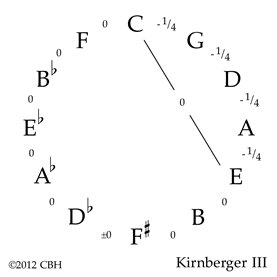Technical Library
TEMPERAMENTS VI: Kirnberger III
Entire Contents Copyright © 2018 CBHTechnical LibraryTEMPERAMENTS VI: Kirnberger III Entire Contents Copyright © 2018 CBH |
 WIKIMEDIA COMMONS / PUBLIC DOMAIN |
| Johann Philipp Kirnberger (1721–1783) |
One of the easiest—and most practical—temperaments to set dates from 1779 and is known as Kirnberger III. For a while, some people thought that this might be Bach’s temperament, seeing as Johann Philipp Kirnberger (1721–1783) learnt from the great JS himself. Despite what you might have been taught, Bach neither invented nor used Equal Temperament. He probably used many different tuning systems—and if he had one particular one in mind for any of his works, he never chose to write clear directions for setting it. Note that his great opus is called the Well-tempered Clavier in English, not the “Equal Tempered Clavichord”, as it has too often been mistranslated. You will find several other Bach temperaments discussed later in this series.
There are other commas to learn, and a whole load of other technical guff if you really want to get into this quagmire, but here you will forgive me if we regard the syntonic comma as for all practical purposes the same size as the Pythagorean. After all, don’t you just want to tune your harpsichord instead of go for a science degree?
 Here’s how you go about setting Kirnberger III:
Here’s how you go about setting Kirnberger III:
1. Tune your c'' (that’s the c one octave above middle c'!) to a tuning fork or other pitch source, and then tune middle c' in absolute pure tune below it.
2. Now we want to determine the e' a pure third above middle c': This will be a revelation if you have never heard a pure third before—Your violinist friends are going to find it unbearably flat, but we want it in perfect tune. (Hint: If you split your interval over the octave, you will find it easier to hear because the speed of the beats is halved. If your left hand is big enough, tune down a pure octave from middle c', and stretch to play the interval of a tenth from c to e'.)
3. Tune all the fifths from the flat side of C around the circle of keys absolutely pure. Stop about the D♭, and begin again working around the sharp side of E, tuning all those fifths absolutely pure. (In theory, you’ll end up with one fifth a little narrow, in fact very close to an equal tempered fifth, but in practice, they should all sound pretty much pure.)
4. Next, the hardest part of this temperament. Make all the fifths around the circle between C and E equally narrow and rough. We are dividing the comma among these four fifths, instead of the twelve of Equal Temperament, so they are going to be three times as out of tune as the equal tempered fifths we know and love on the piano. To tune a narrow fifth, first tune it pure, then lower the top note (or raise the bottom note) until it is beating so much you can’t bear it any more. That’s probably about a quarter of a comma! All those four fifths C–G, G–D, D–A and A–E should sound equally rough. Don’t move your c' or e'—you’ve already tuned them, and must keep that interval as the beautiful pure third. (Actually, it wasn’t that hard, was it?)
The diagram shows a little representation of what you have done using the circle of fifths. The minus sign in front of the quarters means you have a narrowed interval, in this case a quarter-comma narrow, and the line joining the C to E denotes your pure third. All the zeros around the fifths represent those easy to tune, absolutely pure fifths you have mastered!
Again, when you are happy with your middle temperament octave, you must bring the rest of your instrument into tune with what you have done. Tune down in octaves from your temperament area to the bottom of the keyboard, and up in octaves to the top, then bring your other choirs into tune with your first register by proceeding from bass to treble, checking as you go. If your c'–e' is pure in the middle of the keyboard, it should also be pure everywhere else. Likewise, those pure fifths in the diagram will remain pure no matter which octave you might play them in.
Learn this temperament well, because it forms a good base for further exploration of temperaments on the subsequent pages.
Further discussion
Anonymous [Kayano, Moxzan] Dodecagon — Chi-s akt temo Tokyo 2012, p30
Asselin, Pierre-Yves Musique et Tempérament Éditions Costallat, Paris 1985, p92
Jorgensen, Owen The Equal-beating Temperaments The Sunbury Press, Raleigh 1981, p26 (“Aron-Neidhardt Well-Temperament”)
Klop, G C Harpsichord Tuning Werkplaats voor Clavecimbelbouw, Garderen 1974, p23
Padgham, Charles The Well-Tempered Organ Positive Press, Oxford 1986, p68
| Pitch nomenclature | |
| Harpsichord Tuning Process | |
| Tuning Bibliography | |
| Technical Library overview | |
| Harpsichords Australia Home Page |